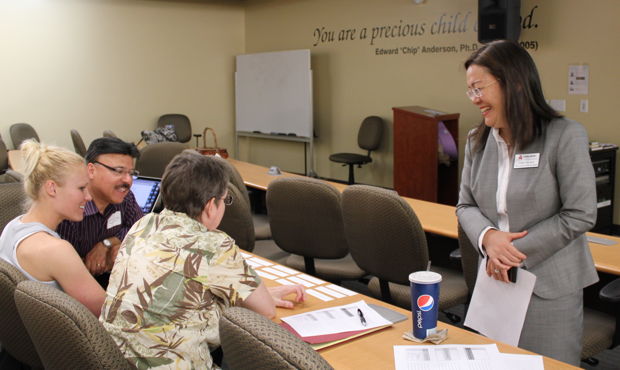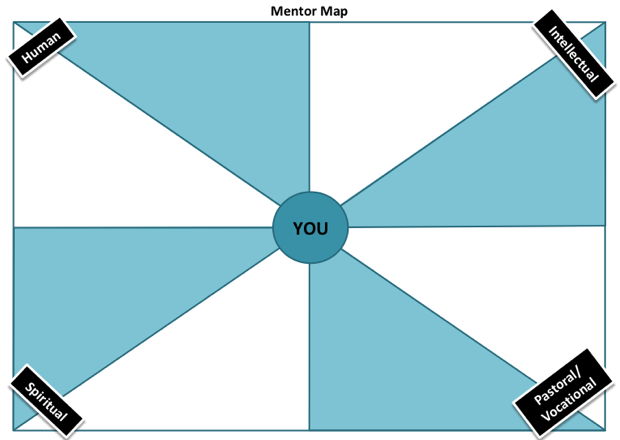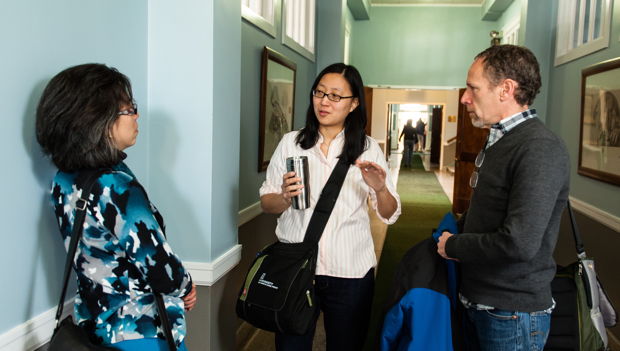There is one thing I would change if I had my journey to do all over again: I would have been more intentional about completing my crew. I would have figured out earlier where the holes were in my crew and strategized how I might connect with folks who could help me develop in specific areas. I would have created a mentor map — listing the areas of my life and work where I could use mentorship and then identifying who was already in place and where I could use additional guidance.

The author in discussion with students at Azusa Pacific University.
Mentoring and the four pillars of formation
One way to begin forming a mentor map (illustrated below) is to draw from the Roman Catholic notion of “four pillars of formation,” identifying mentors (e.g., individuals, communities, services, other resources) in our lives who could be understood as informing each of the four formational areas: human, spiritual, intellectual, and pastoral/vocational. There are a number of resources that provide a more thorough explanation (e.g., Program of Priestly Formation), but here I offer brief descriptions of the pillars and place my mentors in this framework, as an example.
- Human formation involves developing character and qualities that make us more fully who God created us to be. For me, a high-ranking administrator and the dean’s administrative assistant (both of whom were women), with their emphases on knowing my value and maintaining integrity, informed my journey in this area. I bolstered my sense of self-worth and gained a healthier understanding of intention for the greater good with guidance from these two.
- Intellectual formation resides in the cognitive realm, in the academic realm for me in higher education. Encouragement from a faculty colleague to develop my intellectual capital led me to immerse myself in a discipline (or two). Not only did I gain knowledge purely for the joy of learning, but because of him, I was also better prepared for the strategic role that knowledge would play in my emerging professional journey.
- Vocational formation, for those of us not in parish ministry, is about development of professional skills and perspectives needed for functioning in a career. The executive director of a national organization and a faculty colleague from another institution (again, women) provided frames for traversing the political terrain gracefully, while making sure that I didn’t burn my networks. I have also been formed vocationally by a number of reverse mentors, younger professionals with a natural disposition for technology and social media.
- Spiritual formation encompasses personal growth in faith and the development of religious disciplines. My church’s lead pastor can be located in this quadrant, while also straddling the vocational formation area. Our mutual exchange (when I was the church board moderator, lay counterpart to his lead pastor position) took place where spirituality meets social relevance. I also find my mother in this quadrant, intersecting with the human formation area. I have learned from her to become more completely human as I form in my spirituality

To use the Mentor Map, place the names of current mentors in the white blocks for each of the four formational areas and then write in the shaded areas the names of those who you want to invite to be your mentor. Mentor Map by Debbie Gin, Association of Theological Schools. Women in Leadership; October 23, 2014.
Take advantage of opportunities to add mentors
Looking back on my professional trajectory, I can see how my crew appears complete. But earlier on the journey, I remember having only a vague sense of a future path. I have observed this to be true for many women: we attend to the many care-related roles (e.g., children, elder parents) for which we have been socialized personally, while stumbling along almost aimlessly without the same clearly defined social expectations to guide us professionally. Then a mentor crosses our path, and we begin to ask more focused questions of ourselves because of this encounter. Had I used a mentor map earlier, and recognized the gaps in the map, I would have spared myself many years of aimless wandering. I would have sought out my vocational mentors, in particular, much earlier on my journey. Both of the vocational mentors I mentioned were presented to me: one contacted me to be a mentor to others with an organization for Asian women (and happy serendipity that she became my mentor) and the other found me at an ATS event for emerging leaders. Bottom line: take advantage of opportunities to connect with others, even in fields distant to yours. You might be surprised to find mentoring gems!

Special guidance for women: seek out a sponsor
In a study I conducted, I identified a profile of women who would pursue upper-level administration in higher education, specifically in theological education. One characteristic of these women is that they have had ample opportunities to use leadership training. But finding opportunities to lead is often difficult for women because of systemic reasons (e.g., women are not seen as having good potential to lead). One way to address this difficulty is to find another kind of mentor, a sponsor perhaps. This is a person of influence, who has access to leadership circles that you do not. For me, this was my dissertation advisor, a revered expert in diversity. She gave me access to intellectual circles in my guild nationally, which led to others calling on me and my expertise because she saw me as having expertise. Another sponsor in my journey was a critically aware white male colleague who is well-networked and well-published. He provided introductions to circles that were previously closed to me locally as well as nationally.
My journey in leadership has been slow but steady, and I am grateful for where I am currently located. Of course, the journey may have taken half this time had I found the gaps in my mentor map earlier and figured out ways to fill these gaps. I believe firmly, however, that we are meant to learn throughout our lives. It is never too late to be intentional about mentoring. So go complete your crew!
(A version of this article was originally written for ATS Colloquy Online)